Affiliate links on Android Authority may earn us a commission. Learn more.



Sony Xperia 5 II
What we like
What we don't like
Our scores

Sony Xperia 5 II
The Sony Xperia 5 II is what many people have dreamt of: a pocketable, easy-to-use phone that packs a punch as strong as any flagship. The Xperia 5 II may be small in stature, but it’s big on features and performance. Is it the compact(ish) powerhouse phone you’ve been seeking? Find out in the Android Authority Sony Xperia 5 II review.
Update, March 2022: Updated with details about the Sony Xperia 5 III, which replaces the 5 II in Sony’s lineup. Revised the recommended alternatives based on the age of the Xperia 5 II and what’s available in the market now.
What you need to know about the Sony Xperia 5 II
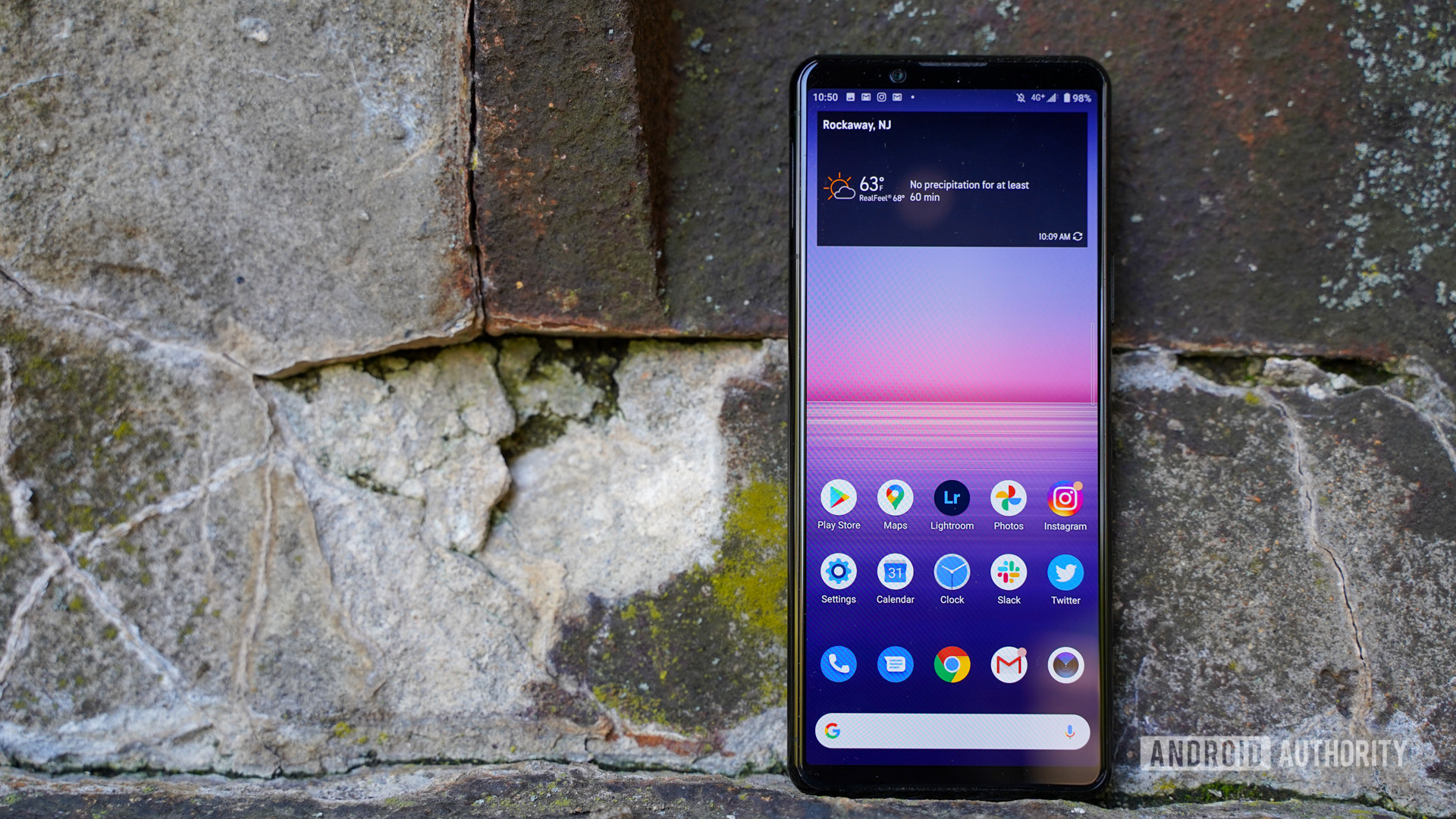
- Sony Xperia 5 II (8GB/128GB): $899/£799
I will admit that I was skeptical about Sony’s brave choice to adopt the 21:9 aspect ratio for its devices. The extreme screen shape mandates hardware that is far taller than it is wide. Some might call the appearance a bit goofy or, at the very least, non-traditional.
While the industry hasn’t fully caught up yet, it’s at least moving in the same direction. More manufacturers are churning out phones with 20.5:9 and 21:9 aspect ratio displays. More importantly, content creators (movies, games) are ramping up the 21:9 content. In other words, Sony actually might have set the trend in this case, or at least read it correctly.
I bring this all up because the Sony Xperia 5 II, a second-generation slice of oblong hardware from the company, is here with its monolithic design and surprisingly advanced features.
This phone is for everyone who’s clamored for a smaller flagship, a petite performer, a tinier terror — in other words, a usable phone that offers all the functionality and performance of a full-sized premium phone.
Its competitors include such fare as the ASUS Zenfone 8 and, maybe to a lesser extent, the Google Pixel 5. It is worth pointing out, too, that the Xperia 5 III has been announced and is on deck for later this year. The Xperia 5 III is an even more impressive feat from Sony, though we have yet to review it.
Design and display
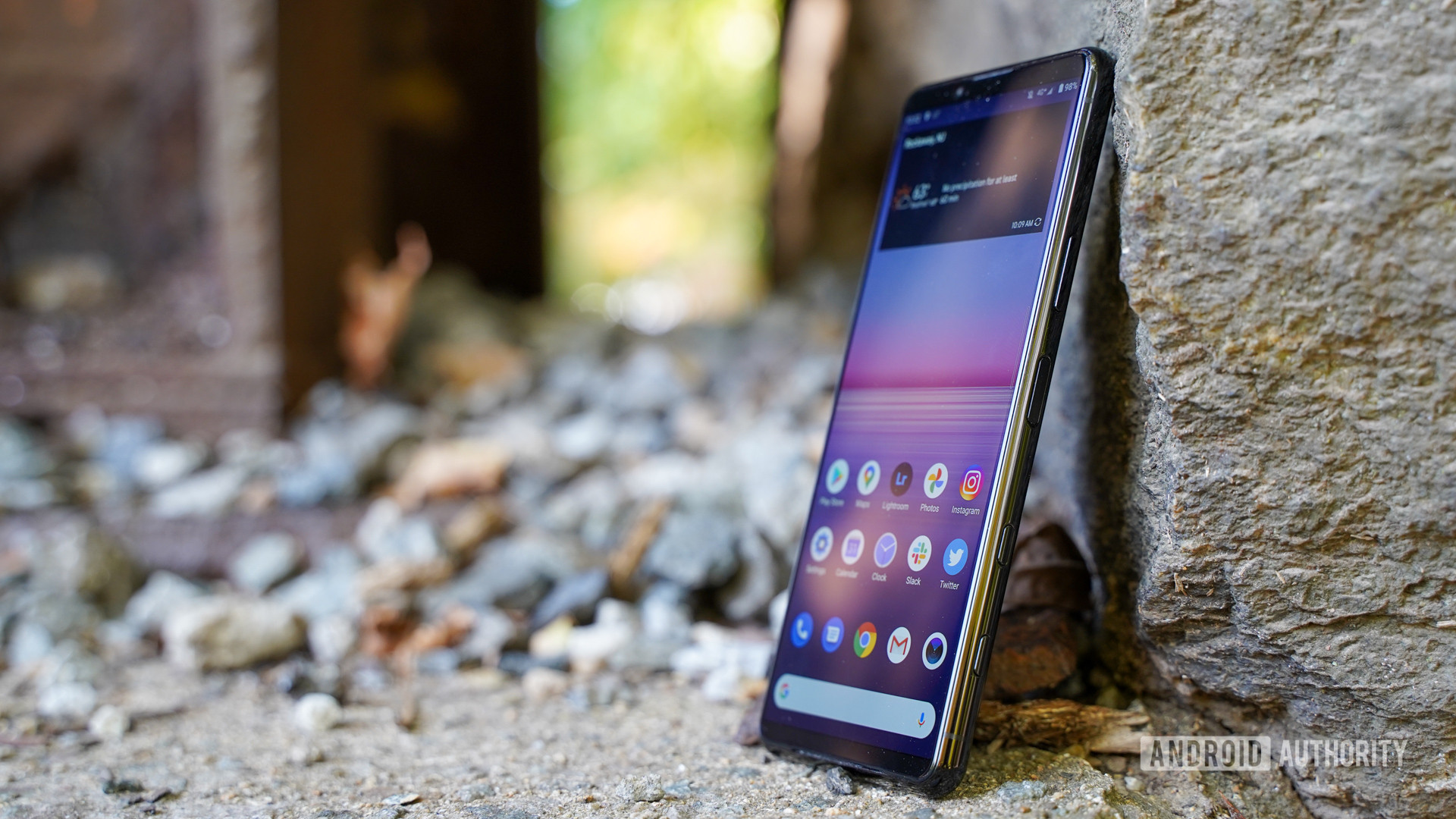
- 6.1-inch OLED
- 120Hz refresh rate
- 240Hz touch scanning
- FHD+ resolution
- 21:9 aspect ratio
- 158 x 68 x 8mm
- 163g
- Black
The 2019 Sony Xperia 5 was an upper mid-range device that wasn’t necessarily meant to compete with top-level phones. It complemented the Xperia 1 and Xperia 10 handsets but didn’t necessarily live up to expectations in our review. The Sony Xperia 5 II is an entirely different beast. Not only is the phone a full-featured flagship, but it also doesn’t cut any corners in delivering its balanced experience. It’s still not for everyone.
We can’t quite pretend that the Sony Xperia 5 II is “small.” The movie screen-like shape of the display means you get a phone that’s narrow from side to side, but really tall from top to bottom. It’s not quite the same shape as most of today’s phones. There is, however, one major benefit to this design: hand fit.
The slim waist of the Xperia 5 II makes the phone comfortable to hold and use in your hand. It’s 5mm to 10mm narrower than many other modern phones. You won’t be stretching your thumb to tap items on the far side of the screen. It is tall at 158mm (6.22 in.) This makes it slightly harder to reach the top half of the screen with one hand. However, the overall dimensions of the phone mean it slips into your pocket with ease. It’s far more comfortable than most other phones to tote around and use as a daily driver.
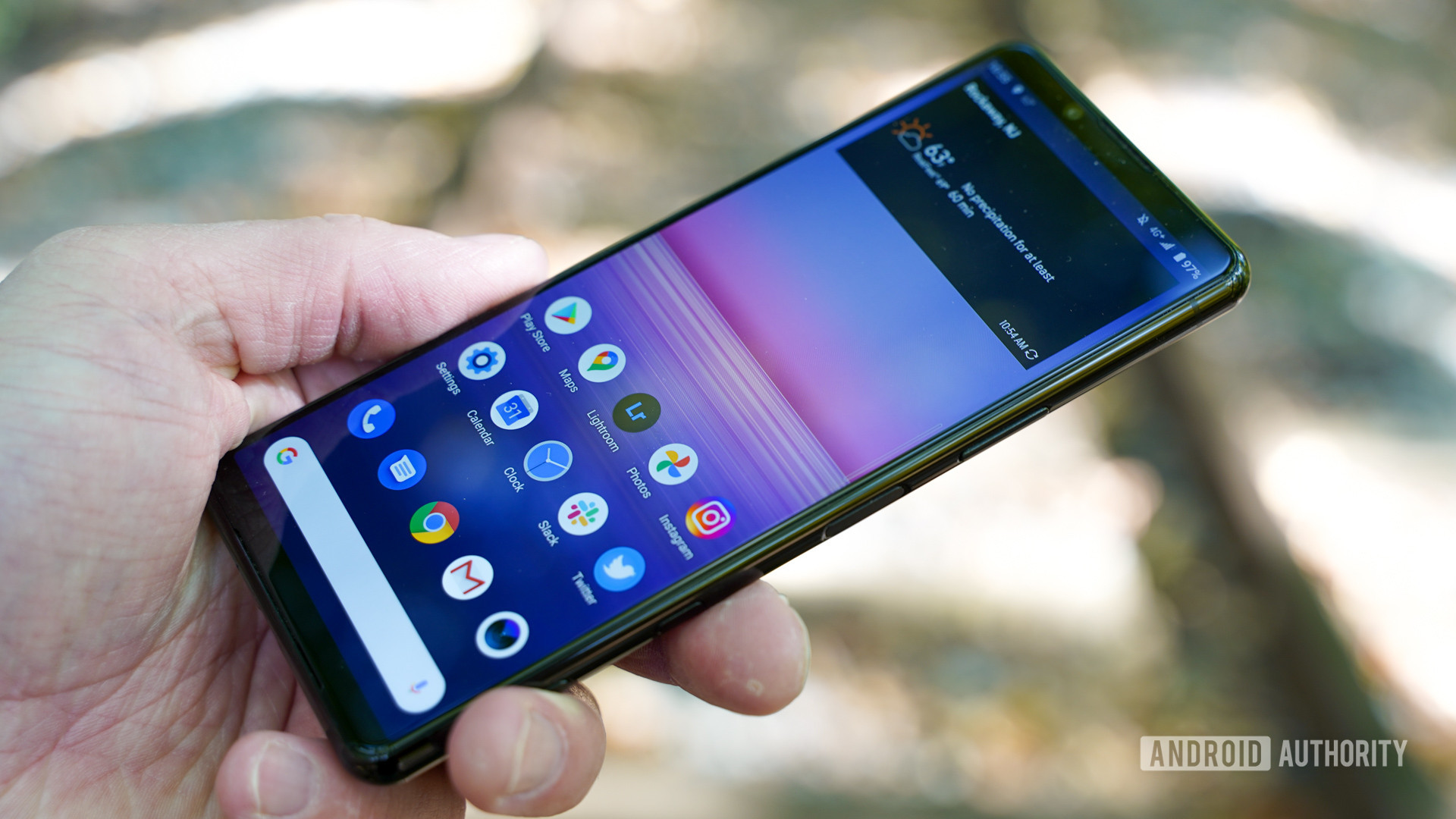
As expected, the Xperia 5 II is a glass and metal sandwich. Gorilla Glass 6 covers the front and rear, while aluminum serves as the meaty filling in between. The frame is quite robust. The glass panels slot into it seamlessly. It’s as strong a chassis as Sony has cooked up in recent memory. It’s rated IP65/68 for protection from dust and water.
Sony gave the phone lots of functional design elements too, most of which are on the right edge. There’s a volume toggle, which I thought was a bit small, as well as a power button that doubles as a fingerprint scanner. The reader worked perfectly once it was trained, though the training took several attempts per print. Sony stuck a dedicated Google Assistant button below the power key, followed by a dedicated camera button closest to the bottom edge. It’s a lot. The Google button barely has a profile at all, which makes it hard to find in a hurry. The two-stage camera button is a bit better.
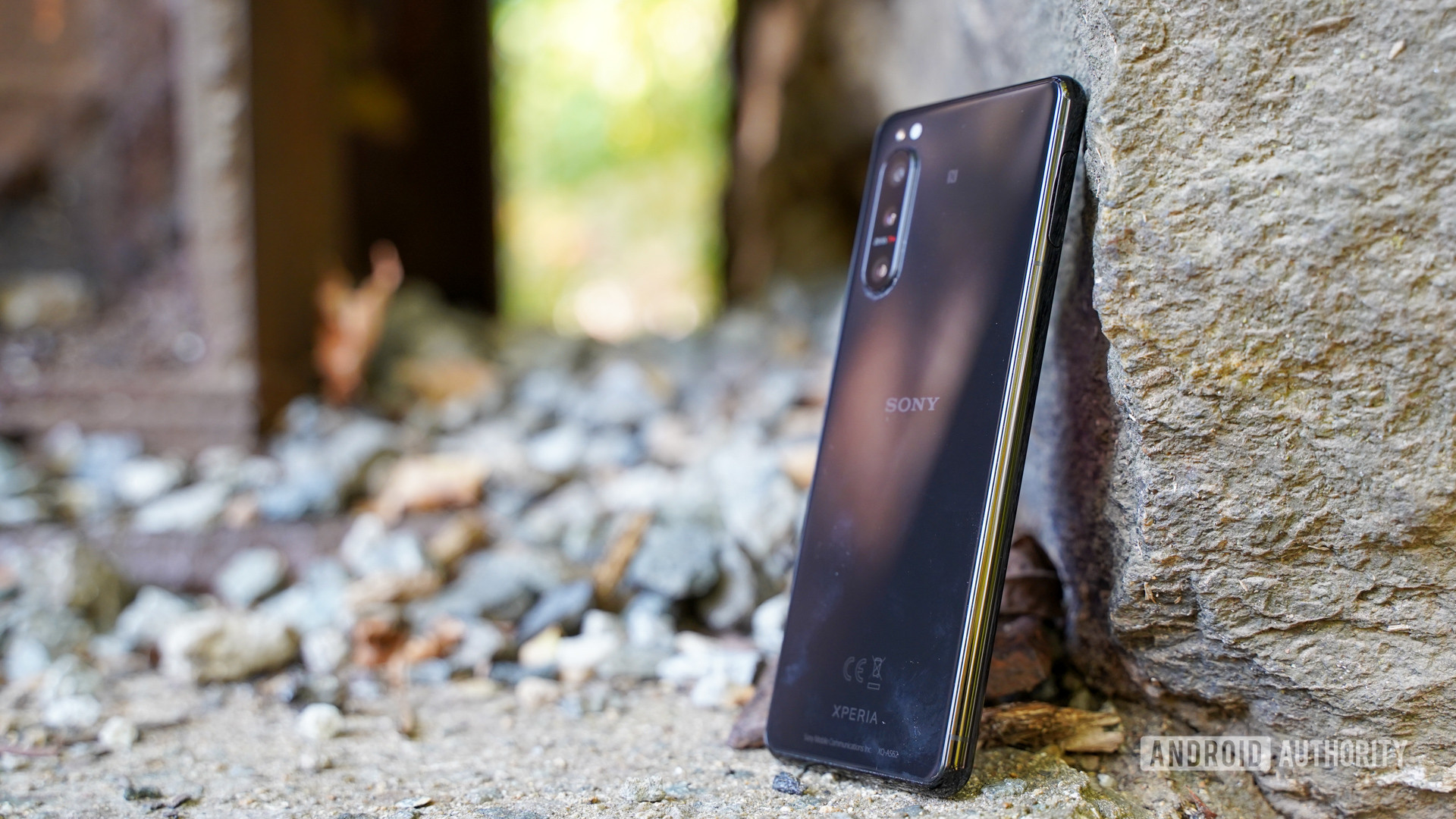
A headphone jack graces the top edge of the phone, while a USB-C port is centered on the bottom. A tray that holds both SIM and memory cards is tucked into the left edge of the phone. I particularly like that you can remove it with your thumbnail. Stereo speakers are located at the top and bottom of the display glass.
Sony did a bang-up job with the hardware.
The rear surface is fairly typical for a modern smartphone. That means there’s a noticeable camera hump near the top. Sony’s triple-lens system runs vertically in the upper left corner. It’s much more modest when compared to the hulking camera modules on today’s Samsung phones. The rest is flat glass.
Sony decided on a single color, black, for the Xperia 5 II. It’s fine, but I miss the purple color that Sony used to offer on some of its phones.
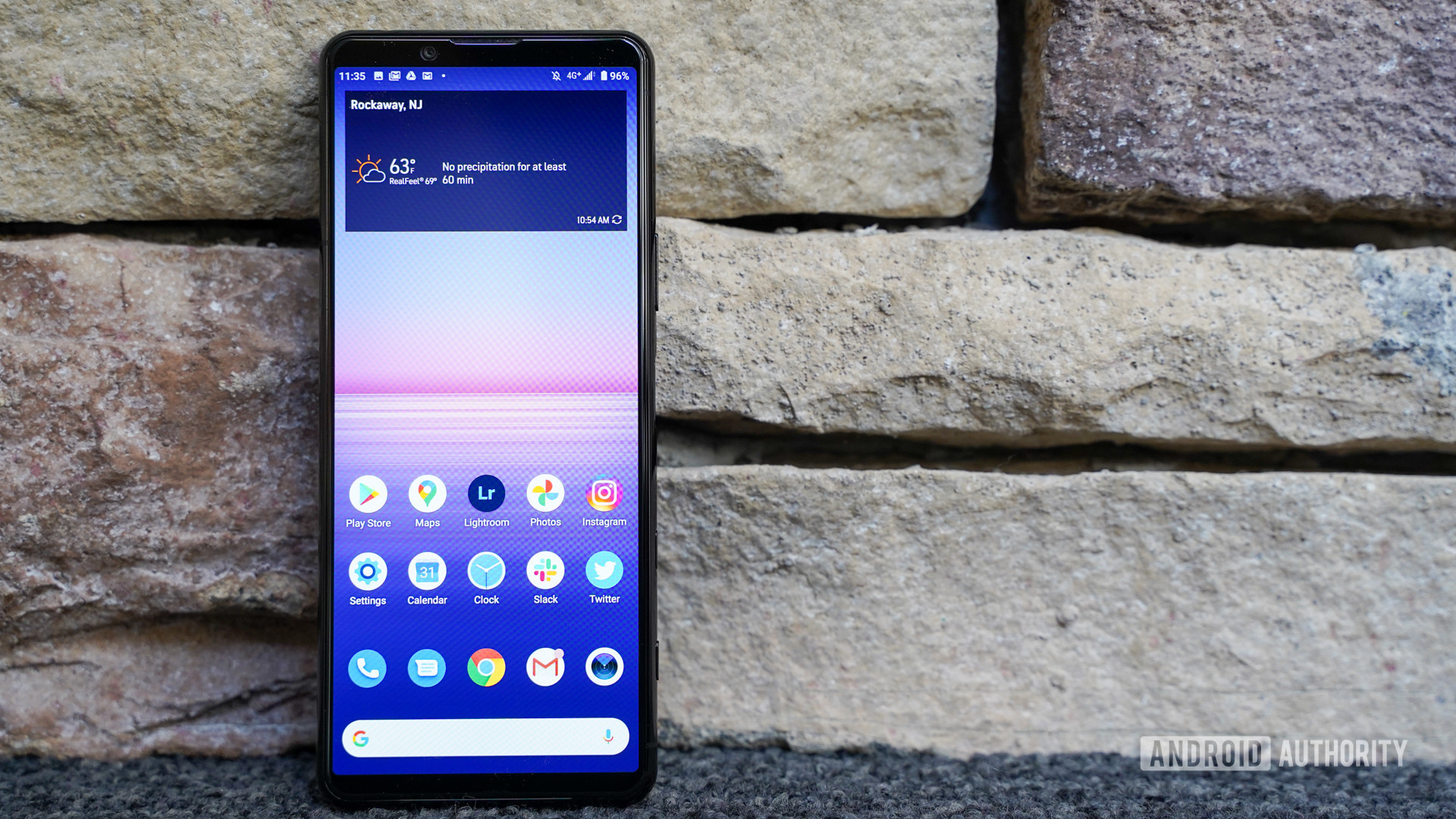
There is a lot to like about the 6.1-inch display. The OLED panel has a 120Hz refresh rate, which makes motion look smooth as you scroll up and down or transition from screen to screen. You can set the display to 60Hz if you want to conserve the battery. In addition to the fast refresh rate, it’s also highly responsive to touch with a 240Hz sampling rate. This makes it ideal for gaming.
As for the screen’s real-world performance, I can tell you that it looks great. The combined size, shape, and Full HD+ resolution mean you have plenty of pixels beaming at you brightly. Viewing angles are excellent, and I didn’t encounter glare or fingerprint problems.
One thing to note about the screen is that it offers two color profiles: standard mode and creator mode. The former offers an expanded color gamut for a brighter and more vivid effect, while the latter is all about color accuracy for creators. It looks less exciting to the eyes but helps photographers and videographers see a faithful reproduction of their content as they create it.
Sony did a bang-up job with the hardware.
Performance
- Qualcomm Snapdragon 865
- Adreno 650
- 8GB LPDDR5
- 128/256GB UFS 3.0
- 4,000mAh
- 21W charging
Processor
Sony packed the Xperia 5 II with the expected processor and RAM arrangement for a 2020 flagship phone. That means the Qualcomm Snapdragon 865 and 8GB of RAM. I appreciate that the phone comes in two different storage options and supports microSD cards for expandable storage too. Today’s flagship phones ship with the Snapdragon 888 processor, which is a generational leap over the 865. Still, the 865 performs well even today.
In everyday use, the phone felt fluid and fast. There were no slow-downs, stutters, or lags, even when the 120Hz display was pushing the processor. I ran some benchmarks and the phone returned the expected results for 2020. It beat 99% of other devices that had run GeekBench and 3DMark at the time, for example. I played a few games to see how it fared and came away impressed. Asphalt 9 looked amazing on the 21:9 display and ran absolutely perfectly on the Xperia 5 II. I didn’t see a single frame drop.
Sony has beefed up the phone's ability to play games, and it shows.
Sony has beefed up the phone’s ability to play games, and it shows. For example, it offers 240Hz motion blur reduction to create clean, blur-free action. The company also included what it calls Game Enhancer. This tool lets you customize the controls for games, as well as easily access your Quick Settings panel for adjustments. Let’s not forget the 240Hz touch sampling rate of the screen, which makes it more responsive to your input when gaming.
See also: Snapdragon SoC guide: All of Qualcomm’s processors explained
Bottom line, the Sony Xperia 5 II was a performance monster when it was released and should be on your shortlist even in 2021 if you’re a gamer looking for a slimline smartphone.
Battery
A smallish phone means a smallish battery. Still, at 4,000mAh the Xperia 5 II’s power cell is much larger than its predecessor’s 3,140mAh battery. It’s nothing to scoff at. Sony says it shrunk other components within the chassis so it could enlarge the battery while keeping the overall dimensions of the phone the same as its predecessor. The company also has all sorts of software onboard to manage battery life, including its Stamina Mode.
What you need to know is that I got a killer battery life with the Xperia 5 II. It routinely posted more than eight hours of screen-on time per day, with enough juice to last from breakfast to bedtime and beyond. The phone often had 25% or more left in the tank at the end of the day, which was enough to reach lunch the following day.
I got killer battery life with the Xperia 5 II.
That’s all with the display set to 60Hz and Stamina Mode off, which is the default. If you bump the screen to 120Hz, you’ll see a significant hit to battery life. The phone still got through an entire day, but screen time was closer to seven hours and it had less than 10% of a charge left at bedtime. That’s still very good, all things considered.
On the charging front, the 5 II supports 21W rapid charging, but it ships with an 18W Power Delivery brick in the box. It’s not the fastest-charging phone we’ve tested, but it did well enough. It took 30 minutes to reach 50% and just over 90 minutes to fully charge from dead. That’s in line with many other 2020 flagship phones we’ve tested.
If there’s one major feature missing, it’s wireless charging. That’s a major bummer.
Software
- Android 11
The Xperia 5 II shipped with Android 10 last year and has since been updated to Android 11. That’s good news if you’re interested in the phone, though Sony typically only provides two years’ worth of major updates to its flagships. That means you’re done after Android 12 rolls around. That’s not the worst around, but it does pale compared to Samsung and several other manufacturers who offer three years of core updates.
Sony’s software skin adds a light touch to stock Android. You’ll see different background colors, some alternate fonts, and changed icons when it’s put side-by-side with stock Android. However, the user interface provides the standard home screen, app drawer, Quick Settings shade, and adjustable home screen navigation.
The phone carries over some unique features from its predecessors. For example, Side Sense is similar to Samsung’s Edge Screen. Double tapping either side of the frame opens up a small window with shortcuts to several key apps and actions. It could be a bit more reliable when you want to open it. I found it a bit tricky. However, this is where you reach some of the other advanced modes.
There’s a one-handed mode to help with reaching the top of the display. Once you shrink the screen, you can swap it from side to side, or adjust the height to your liking.
Then there’s split-screen multitasking. This works really well on the tall screen. An app assists you in accessing and configuring which applications appear on the screen. I particularly like that you can create app pairs. The Galaxy Note series has a similar feature.
Last, updates. Sony has generally been fairly reliable at pushing system-level updates to the majority of its phones. It may not be the quickest to get the updates out, but they do get there eventually.
Camera
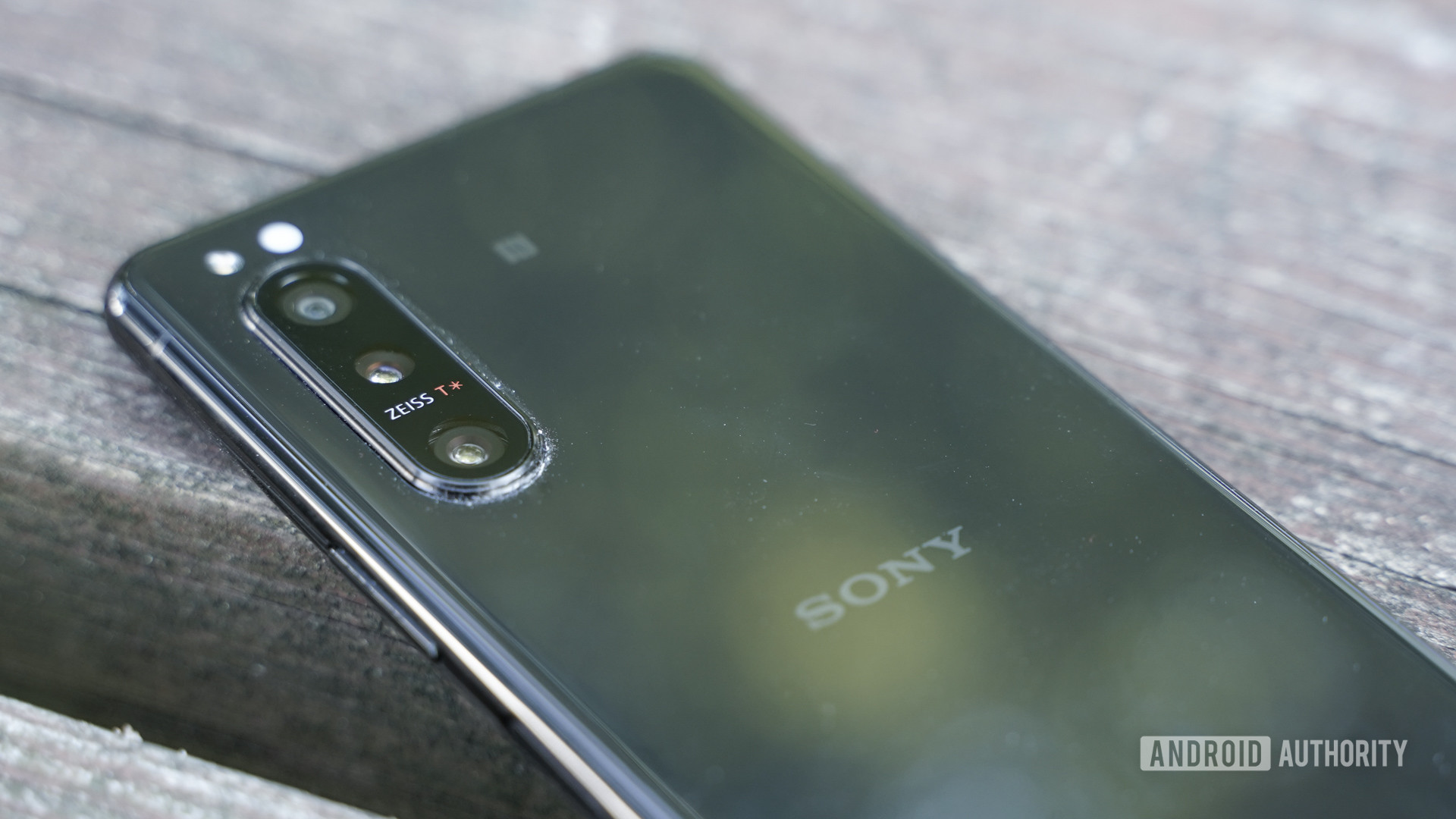
- Rear:
- Ultra-wide: 12MP, 16mm
- Wide: 12MP, 24mm, f/1.7, PDAF
- Telephoto: 12MP, 70mm, PDAF, OIS Eye AF, 20fps
- Front:
- 8MP
- Video:
- 4K at 120fps
Sony went for broke with the cameras. The company has long touted top photography tech while fielding only mediocre cameras. As it did with the Xperia 1 II, the Xperia 5 II borrows a page from Sony’s vaunted Alpha line of cameras. It even bakes in a pro mode that ports over the menu system from Sony’s mirrorless cameras. It’s a lot to take in, so let’s start with the basics.
The phone has a triple-lens setup with ultra-wide, standard, and telephoto options. Sony says it relied on typical prime lenses to guide its choice of focal lengths, which are 16mm, 24mm, and 70mm for ultra-wide, standard, and zoom lenses, respectively. The lenses all boast ZEISS optics for added clarity. Some of the features include Real-time Eye AF, which continuously seeks out the eyes of subjects and focuses there. The continuous autofocus performs calculations up to 60 times per second for shooting at up to 20fps.
The Photography Pro app is certainly advanced, but it's not easy to master.
There are two camera apps, a standard one, and the Photography Pro app. You should be familiar with the standard app, as it’s the same one Sony has used for several years now. It’s a breeze to select between photos and video, as well as dial-in advanced settings such as aspect ratio, timers, white balance, and more.
The Photography Pro app is for photography lovers who are familiar with the menu system of Sony’s Alpha cameras. It’s not easy to master, but it is certainly advanced. You can see in the sample screenshots below how involved the menu is. The Photography Pro app is powerful, but you have to know what you’re doing to make the most of it. Most regular users will likely find it overwhelming.
In general, the photos I got with the Xperia 5 II were good. There’s a distinct film-like look to many of them, for better or worse. I’d almost swear I was shooting on Kodachrome. It’s the color and grain that lead to this effect. The photos have a warmth to them, with natural colors that aren’t oversaturated or boosted in any way. Everything I shot looked spot on in terms of accuracy. In other words, what I saw in the real world is what I saw in the photos.
You can sort of get a feel for it in the samples above. What’s really interesting is that the effect is similar across the three cameras, which we like to see.
Facets such as white balance seemed to skew a little toward yellow, while sharpness came across a tad soft. Even so, I appreciated the look. HDR performance could have been a little better. There’s not quite as much detail in the bridge shot (below) as I would have liked. On the other hand, the waterfall shot was able to balance the darkened leaves on the left side of the frame with the really bright falls. I like the contrast visible across the shots that I took.
The front camera does okay. You can see a standard selfie and a portrait selfie in the samples below. I wish the portrait selfie created a stronger bokeh effect in the background. I also look a bit overexposed. The standard selfie comes across as a little better, particularly the skin tones.
Even though the phone has two separate camera apps, the photos it produces are the same. You can see in the samples below that the regular app and the Photography Pro app generated similar results.
Then there’s video. Sony made a lot of noise about the Xperia 5 II’s video capabilities. You can shoot video with the standard camera app, which is what I recommend, or you can futz with the Cinematography Pro app. The latter is maddeningly complicated and just no fun to use. It gives you wide control over nearly every facet of the video camera’s behavior, such as frame rate, ISO, shutter speed, and so on, but it’s difficult to put to effective use unless you really know what you’re doing. Thankfully there’s a tool called “Look” which lets you select from eight different video presets, each of which has a different vibe.
More reading: The best triple camera phones: What are your options?
The results speak for themselves. The 1080p 60fps footage I captured looks very good. I was pleased with the tone, color, and warmth of the video. You can jump to 4K at 60fps if you wish, and those results look very sharp. The one trick feature of the phone is that it can capture 4K at up to 120fps for 5x slow-motion playback. The results are smooth and fluid. Sony claims this is a first.
Full-sized photo samples can be viewed here.
Audio
We’d be remiss if we left out audio. To start, the phone has a headphone jack — something the majority of flagship phones lack these days. Sony says the headphone jack provides clearer left and right audio separation, which makes it possible to reduce signal noise to just 20dB. But that’s the least of what the Sony Xperia 5 II offers.
See also: 15 best music player apps for Android
Sony loaded the phone with audio features. First, Dolby Atmos sound. This ensures that movies sound amazing. Then there’s 360 Reality Audio hardware decoding to optimize your music experience. The phone packs DSEE Ultimate, which up-converts your audio music files with improved audio frequency and dynamic range, for high resolution wired and wireless sound.
Last, it has stereo speakers. I sampled some music via the speakers and they sound excellent. They can pump out clear, loud sound that is crisp and not over-driven. Similarly, the music I pushed through the headphone jack to my favorite pair of wired headphones sounded as clean as a whistle.
Sony Xperia 5 II specs
| Sony Xperia 5 II | |
|---|---|
Display | 6.1-inch OLED 120Hz refresh rate 240Hz touch scanning FHD+ resolution 21:9 aspect ratio |
Processor | Qualcomm Snapdragon 865 Adreno 650 GPU |
RAM | 8GB |
Storage | 128 or 2565GB |
Camera | Rear: Ultra-wide: 12MP, 16mm Wide: 12MP, 24mm, f/1.7 aperture, PDAF Telephoto: 12MP, 70mm, PDAF, OIS Eye AF, 20fps tracking Video: 4K @ 120fps Front: 8MP |
Battery | 4,000mAh 21W charging |
Audio | 3.5mm headphone jack Stereo speakers Dolby Atmos DSEE 360 Reality Audio |
Dimensions and weight | 158 x 68 x 8mm 163g |
Color | Black |
Value and competition
You can’t balk at what Sony’s phone delivers. The Sony Xperia 5 II truly captures the flagship experience in a somewhat more compact form factor. That’s not easy. It has, however, since been eclipsed by the Xperia 5 III.
The 5 III is a newer version of the 5 II and it makes significant improvements along the way. In addition to a bigger battery, it has an upgraded processor, and, critically, support for 5G networks. These updates make the Xperia 5 III a much better buy at this time. Moreover, the Xperia 5 II appears to only be available in renewed form from sellers such as Amazon.com.
The Xperia 5 III ($999) is just $50 more than the launch price of the 5 II. It’s a very pricey phone and it goes head to head with the best from Samsung, which includes the new Galaxy S22 series. Its most direct competition is the Galaxy S22 Plus ($999), which has the same base pricing and feature set. The Xperia 5 III is, however, closer in size to the smaller Galaxy S22 ($799).
If you have a bit more to spend, you might consider the pricer Xperia 1 III ($1,299), which is a bigger phone though it offers many of the same design points and features of the smaller 5 III. The biggest differentiator is that it has a 6.5-inch 4K screen that is to die for.
Other devices that play in the thousand-dollar space include the Google Pixel 6 Pro ($899), which has a better camera than the Xperia 5 II, the OnePlus 10 Pro (~$999), which should reach global markets in late March or early April, and the Xiaomi 12 series.
Sony Xperia 5 II review: The verdict
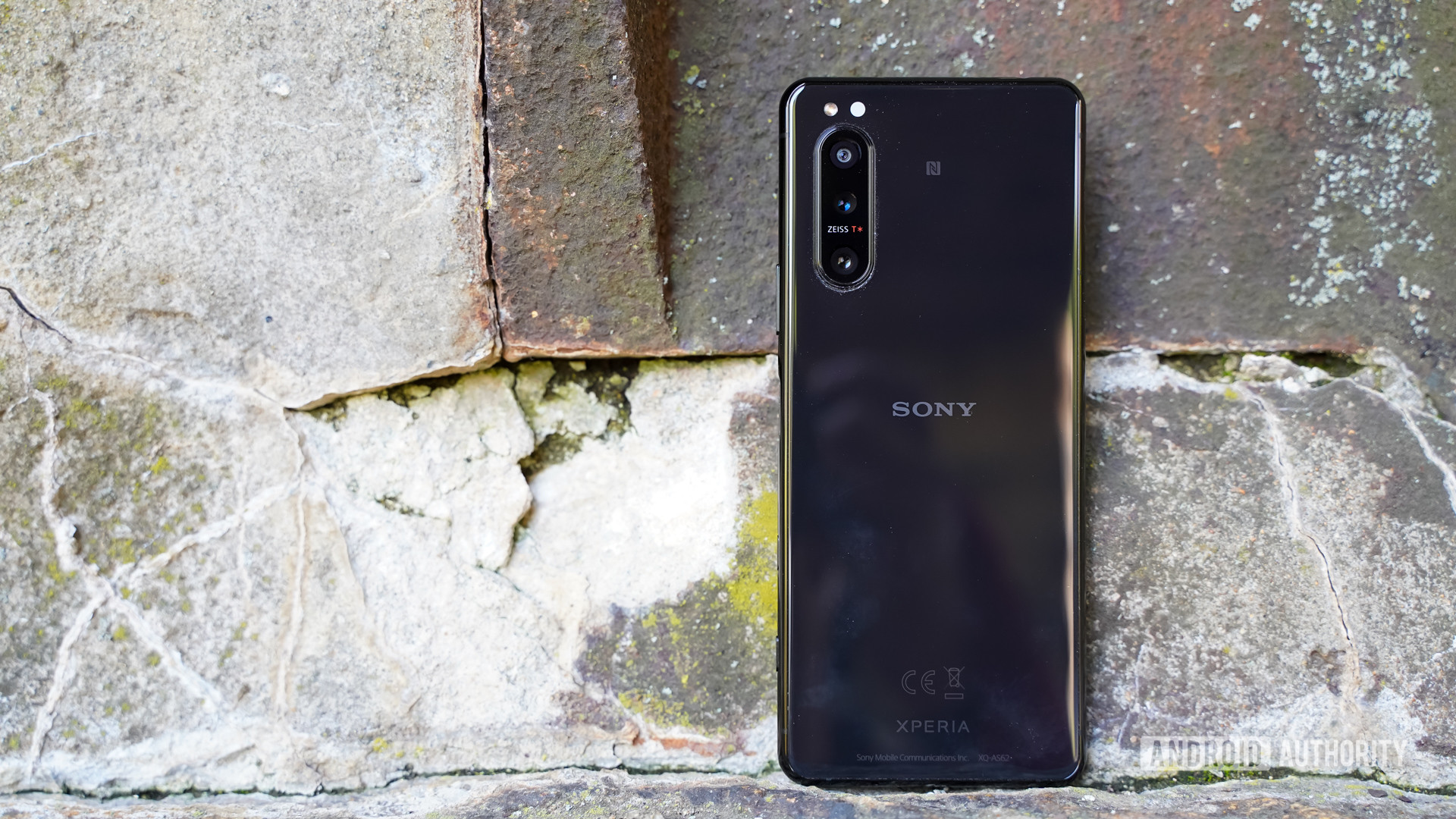
Sony truly cooked up an excellent smartphone in the Xperia 5 II. It’s a testament to the company’s engineering that it was able to pack so much into a phone that’s more pocketable and easier to use than most competing flagships. It’s not small, per se, but it is more usable than today’s platter-o-phones. For that, and the fact that it’s not at all watered-down, it deserves credit.
The hardware is simply excellent. It may look awkward, but the phone has a great 120Hz display, a waterproof chassis, a headphone jack, and Gorilla Glass 6 front and back. Performance is best-in-class, and battery life is excellent. The software is simple enough to master, and there are some advanced tricks to enrich the experience. The camera app works well and delivers solid results from the triple-lens arrangement. There’s no 8K video capture on board, but I’d rather have the 21:9 and 120fps recording capabilities offered by the Xperia 5 II.
All that said, the Xperia 5 II has since been eclipsed by the Xperia 5 III, which is an upgrade is most ways. Since the Xperia 5 II is mostly unavailable unless in renewed form, we recommend Sony fans opt for the Xperia 5 III or Xperia 1 III instead.